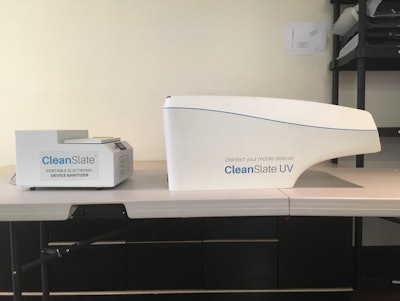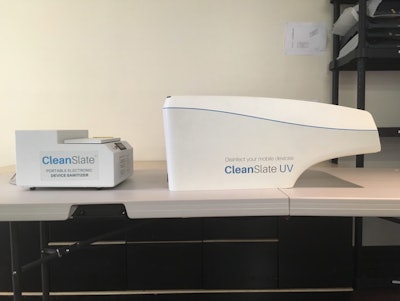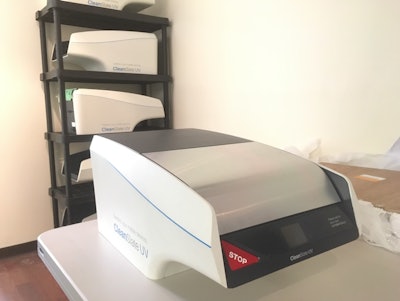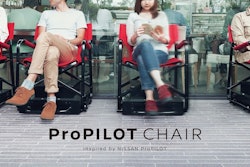

 Taylor Mann, CEO and Co-Founder of CleanSlate UV
Taylor Mann, CEO and Co-Founder of CleanSlate UV Dr. Jeffrey Sachs, Founder and CEO of the Sachs Policy Group
Dr. Jeffrey Sachs, Founder and CEO of the Sachs Policy GroupPlant hygiene and sanitation are top priorities for food and beverage manufacturers. And the increased use of mobile technology inside facilities and on the plant floor — think smartphones and tablets — has given bacteria another avenue to infiltrate the operation.
With that in mind, CleanSlate UV recently introduced the CleanSlate UV Sanitizer. The CleanSlate UV Sanitizer uses UV light to sanitize smartphones and tablets in 30 seconds. Originally designed for use in hospitals, CleanSlate UV has now launched pilot programs in food processing plants in both Canada and New York.
CleanSlate UV CEO and Co-Founder Taylor Mann, and Dr. Jeffrey Sachs, Founder and CEO of the Sachs Policy Group, answered some questions about CleanSlate UV and the CleanSlate UV Sanitizer in this Food Manufacturing Q&A.
Q. How does the UV Sanitizer work? How effective is it?
A. CleanSlate’s UV Sanitizer is very simple. You place your mobile device in a tray and close the lid. Our special chamber design then bathes that device in 360 degrees of UV light, which is a non-toxic disinfectant. Through this very user-friendly system we can achieve a 99.999 percent reduction in MRSA and a 99.99 percent reduction in E. Coli, not to mention a range of other pathogens, in just 30 seconds. — Taylor Mann
Q. How has the use of portable electronics inside food processing plants changed in recent years?
A. The major shift fueling mobile device use in this industry, and in many industries, is the power of mobile-based applications, whether it’s for communication, for auditing, for record keeping or more. Mobile devices have huge potential to make these industries more efficient. But like any tool, facilities need to ensure they are clean without interrupting their workflow. That’s why we’ve seen such quick pickup in this industry. — Taylor Mann
Q. Employees’ personal electronic devices (phones and other mobile devices) pose contamination risk in food processing facilities. How?
A. Just like any tool being brought into a sanitary area, these devices store and transmit bacteria, undermining hand hygiene efforts while creating an independent environmental risk. A large factor here is how often we touch our phones compared to any other personal items (600-800 times per day) combined with how dirty they are. One in six phones contains fecal matter, for instance. — Taylor Mann
Q. How did CleanSlate get involved in the food processing industry?
A. Through the years I’ve worked with a lot of tech startups to help them navigate the challenges of breaking into a new industry. I became a mentor for CleanSlate at a very early stage because I saw how their technology helped solve a serious problem in our hospitals, and that there would be a need for this kind of device elsewhere. More and more, we’re seeing companies allow employees to use their own smartphones and tablets for work purposes. This trend is expanding across all industries, and food manufacturing is no exception. — Dr. Jeffrey Sachs
Q. Where is the UV Sanitizer currently deployed (US, Canada, international)?
A. I worked with CleanSlate to provide guidance at the strategic level, and help them identify and build partnerships with various facilities. They moved very deliberately to get pilot programs off the ground, and will be deploying their 2nd Generation technology in food processing plants in both Canada and New York State. — Dr. Jeffrey Sachs

Q. What areas inside the food processing plant is the UV Sanitizer currently being used?
A. Because of its intuitive design, the UV Sanitizer can be placed anywhere within the facility, but typically it’s being deployed next to handwashing stations, entrances to clean areas or in areas where staff congregate before and after a shift. — Taylor Mann
Q. What do plant managers and employees say they like most about the UV Sanitizer?
A. We’ve received a lot of great feedback on the device from the people working on the plant floor. One thing we’re consistently hearing is that they like how easy it is to use. The UV Sanitizer is simple enough that anyone can walk up to it, instantly understand how it’s used, and safely disinfect their devices. One of the features that plant managers like the most is the RFID-enabled compliance software. This software allows facilities to track their own devices and audit when they were last sanitized. — Taylor Mann
Q. Like hand sanitizing stations, using the CleanSlate UV Sanitizer is mostly voluntary (though recommended) on the part of the employee. What can plant managers do to enforce its use?
A. One of the great things about the RFID tagging software is that it helps enforce the Sanitizer’s use for facility-owned devices. The key feature of the software is that it lets plant managers see in real time when their facility-owned devices are being sanitized and which units are failing to comply with sanitization protocols. For personal devices, one of the most effective ways of encouraging employees to use the Sanitizer is through signage and education. When people become informed about the harmful bacteria living on their cellphones and tablets, they recognize the need to clean their devices. At a selfish level, people want to have clean devices so that when they return home at the end of a day, their child isn’t, for instance, picking up a pathogen-ridden device to play Angry Birds. — Taylor Mann, CEO
Q. What are some of the key advantages that this product has over disinfecting wipes?
A. On paper, some wipes should be able to tackle this problem. But with employees needing to wipe down the entire surface of a device and then leave it to sit for one minute, devices rarely get properly cleaned. Employees in the plant are extremely busy and move quickly from place to place within the facility, so when it comes to sanitizing their cellphones, they need something that works fast. CleanSlate’s Sanitizer fits their workflow because it operates on a 30 second cycle. — Dr. Jeffrey Sachs
Q. What's next for CleanSlate? What is the company's vision for the next 5-10 years?
A. CleanSlate is very focused on expanding the business even further and continues to seek out new opportunities for partnerships. I think one of the key factors that will contribute to CleanSlate’s success in the years to come is their relentless drive to refine, improve and learn. To survive in the infrastructure of a large industry like food manufacturing, startups need to be nimble and flexible, and CleanSlate has that edge. From their first product sketch to their 2nd Generation product design, they’ve been very focused on using customer feedback as the basis for all development. I believe it is this pattern of user focused development that will make CleanSlate the standard in infection control for portable electronics. — Dr. Jeffrey Sachs
About the contributors
Taylor Mann is CEO and Co-Founder of CleanSlate UV. The Toronto-based tech startup was launched in July 2014 by Mann and four of his fellow Queen´s University alumni.
Dr. Jeffrey Sachs is the Founder and CEO of the Sachs Policy Group. As a leading healthcare policy expert and advisor to emerging technology companies, Jeff works with CleanSlate UV among other startups to provide unique, personalized strategies to achieve success in the fast-changing healthcare environment and beyond.






















